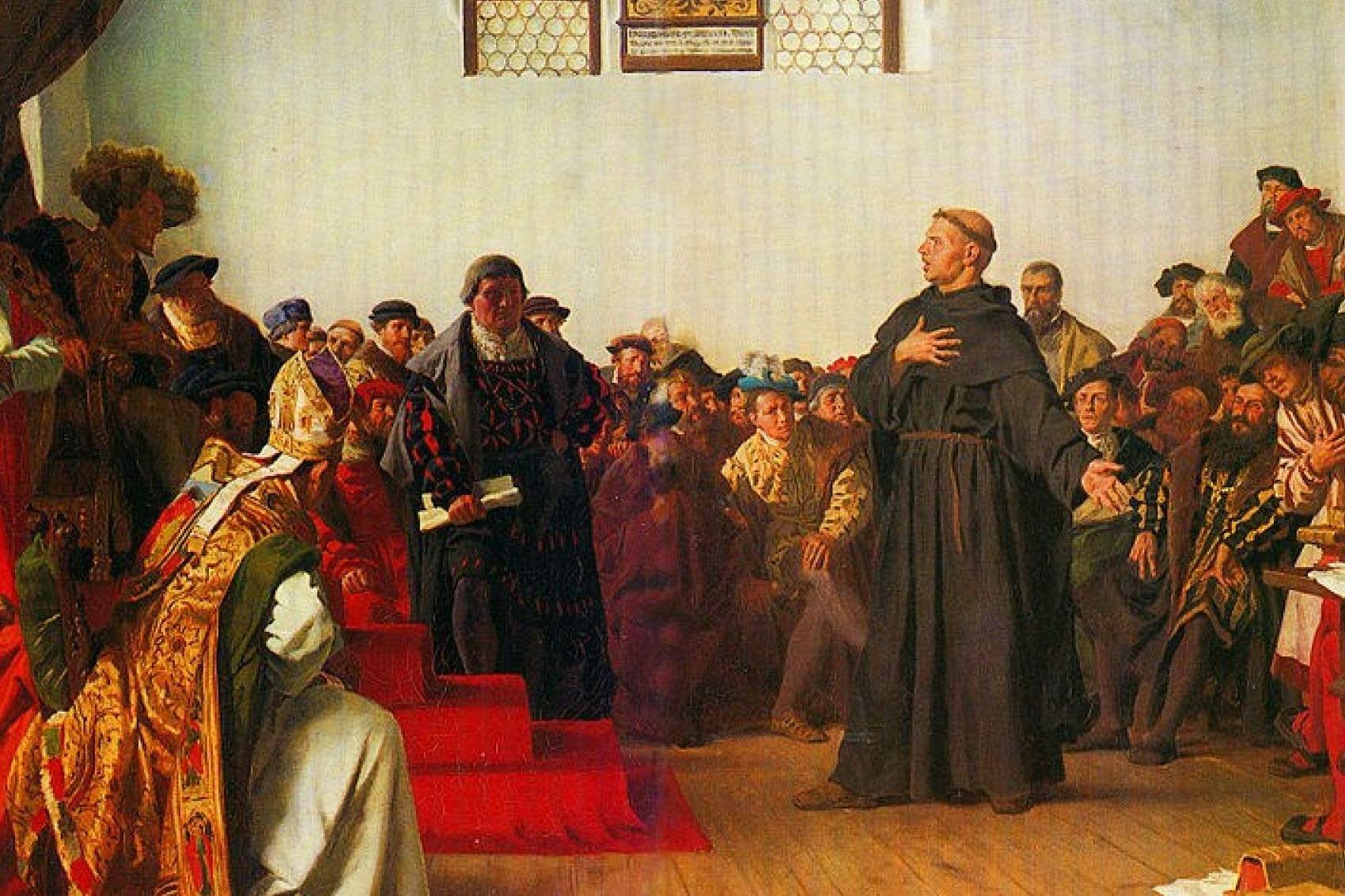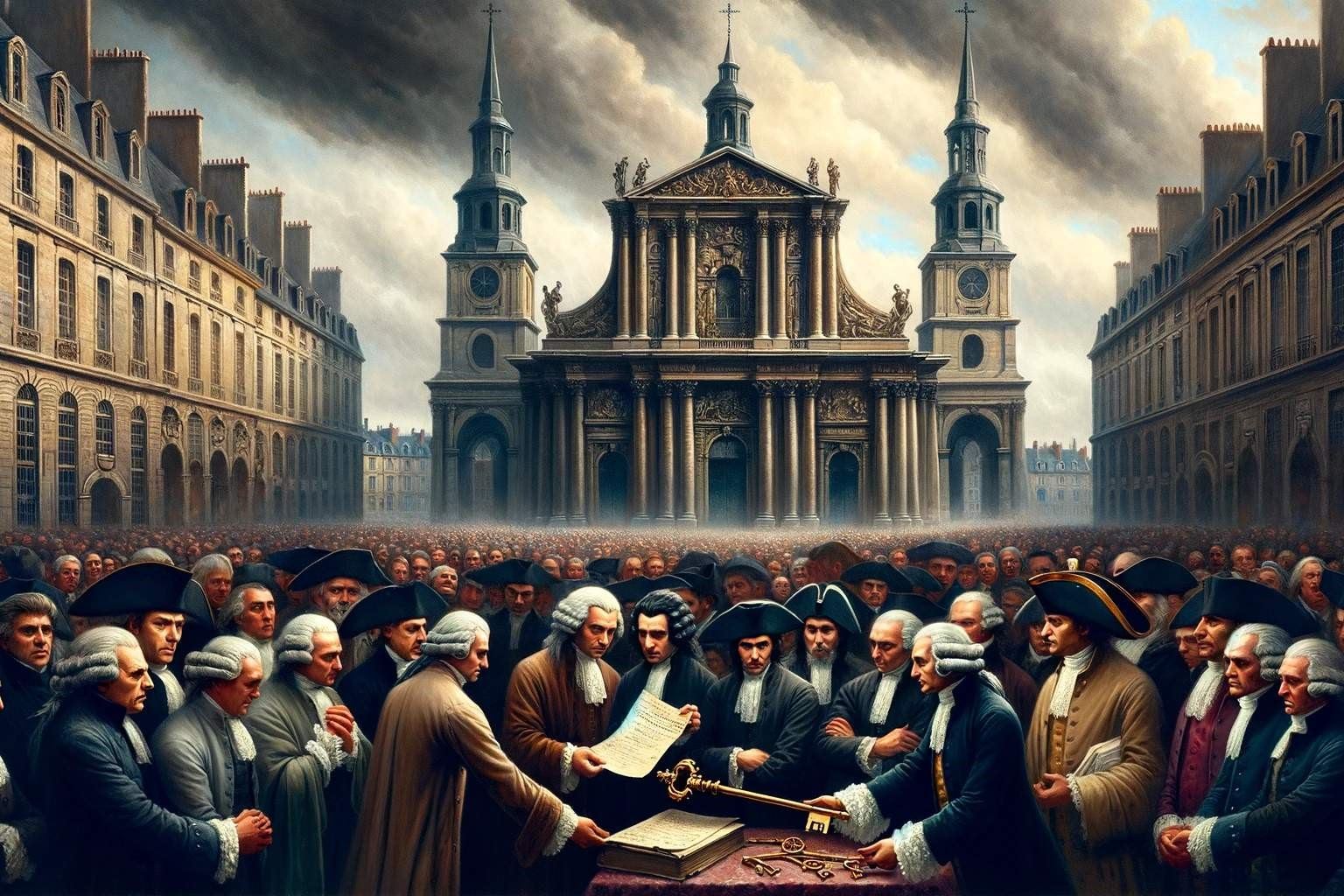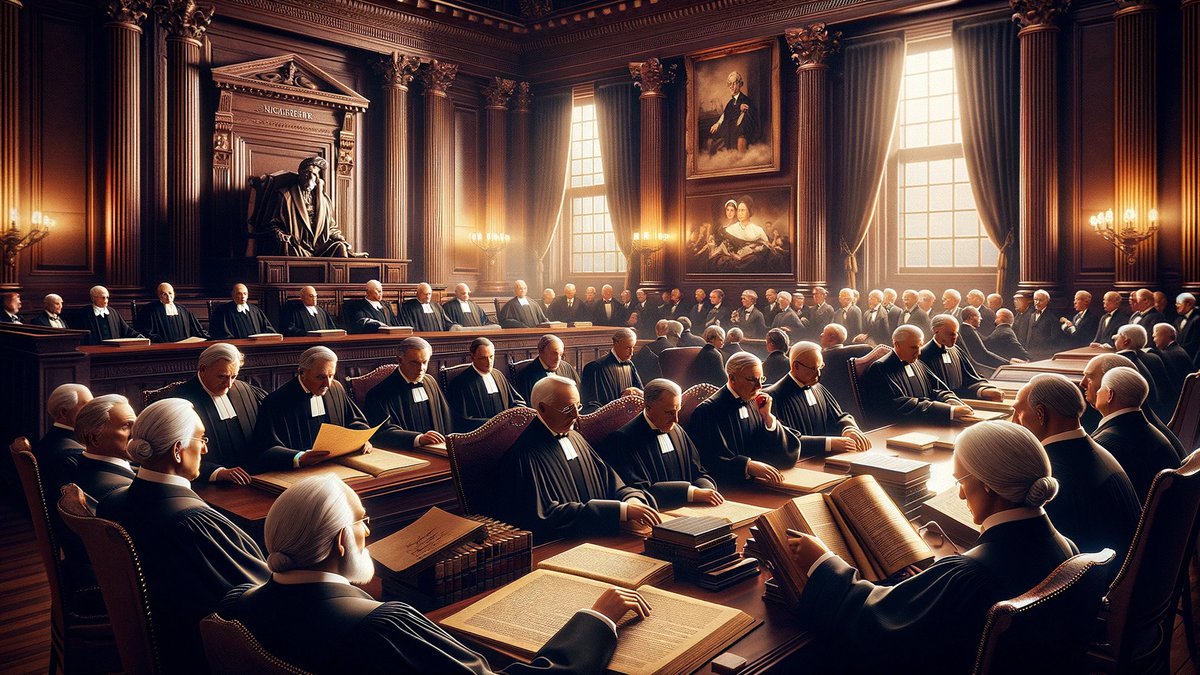Home>Theology and Spirituality>Examples Of How There Was Cooperation Between Church And State


Theology and Spirituality
Examples Of How There Was Cooperation Between Church And State
Published: February 11, 2024
Jason DeRose, Managing Editor at Christian.net, uses his expertise in religion and journalism to deepen understanding of faith's societal impacts. His editorial leadership, coupled with a strong academic background, enriches the platform’s diverse content, earning him recognition in both journalism and religious circles.
Discover examples of cooperation between church and state in the realm of theology and spirituality. Explore the historical and contemporary intersections of religious and political authority.
(Many of the links in this article redirect to a specific reviewed product. Your purchase of these products through affiliate links helps to generate commission for Christian.net, at no extra cost. Learn more)
Table of Contents
Introduction
Throughout history, the relationship between the church and the state has been a complex and often contentious issue. The intertwining of religious and political authority has shaped the course of nations and civilizations, leading to both cooperation and conflict. This dynamic interaction between the spiritual and secular realms has had profound implications for societies, influencing laws, governance, and cultural norms.
The historical examples of cooperation between the church and state provide valuable insights into the intricate balance of power and influence. From the Byzantine Empire to the establishment of the Church of England, these instances illustrate the ways in which religious and political institutions have collaborated, sometimes harmoniously and at other times with significant tension.
Understanding the historical context of these collaborations is essential for comprehending the broader dynamics of power, belief, and governance. By examining these historical examples, we can gain a deeper appreciation for the complexities of the church-state relationship and its enduring impact on societies around the world.
In this article, we will explore several compelling instances of cooperation between the church and state, delving into the historical intricacies and the far-reaching consequences of these alliances. From the Byzantine Empire's fusion of religious and political authority to the complexities of the Spanish Inquisition and the establishment of the Church of England, each example offers a window into the multifaceted interplay of spiritual and temporal power.
As we embark on this exploration, we will uncover the historical nuances and the enduring legacies of these collaborations, shedding light on the intricate tapestry of church-state relations. By delving into these historical narratives, we can glean valuable insights into the complexities of power dynamics, religious authority, and the enduring impact of these alliances on the course of history.
Historical Examples of Cooperation Between Church and State
Throughout history, the relationship between the church and the state has been characterized by a complex interplay of power, authority, and influence. Several historical examples vividly illustrate the dynamics of cooperation between these two entities, showcasing the ways in which religious and political institutions have intersected and collaborated.
The Byzantine Empire stands as a compelling example of the fusion of religious and political authority. Under the rule of Emperor Constantine the Great, Christianity was established as the state religion, marking a pivotal moment in the history of the empire. This alliance between the church and the state not only solidified the authority of the Christian faith but also imbued the emperor with a divine mandate, blurring the lines between temporal and spiritual power. The Byzantine emperors wielded considerable influence over ecclesiastical affairs, underscoring the close collaboration between the imperial court and the church hierarchy.
In a similar vein, the Holy Roman Empire exemplified the intricate relationship between church and state. The investiture controversy, a protracted power struggle between the papacy and the empire over the appointment of bishops, underscored the competing claims of spiritual and temporal authority. The eventual resolution of this conflict through the Concordat of Worms in 1122 delineated the spheres of influence for the church and the state, cementing a delicate balance of power while acknowledging their interdependence.
The Spanish Inquisition provides another poignant illustration of cooperation between the church and the state, albeit in a more contentious light. Established by the Catholic Monarchs Ferdinand II of Aragon and Isabella I of Castile, the Spanish Inquisition was a collaboration between the monarchy and the ecclesiastical authorities to enforce religious orthodoxy and suppress heresy. This alliance resulted in a climate of fear and persecution, underscoring the far-reaching consequences of unchecked collaboration between religious and political institutions.
The establishment of the Church of England during the reign of King Henry VIII offers yet another compelling example of church-state cooperation. Driven by political and personal motivations, Henry VIII sought to assert his authority over the church, leading to the break with Rome and the subsequent establishment of the Church of England. This pivotal moment in history exemplifies the ways in which political imperatives intersected with religious authority, reshaping the ecclesiastical landscape of England.
These historical examples underscore the intricate and often fraught dynamics of cooperation between the church and the state. From the Byzantine Empire's fusion of religious and political authority to the complexities of the Spanish Inquisition and the establishment of the Church of England, each instance offers a nuanced portrayal of the enduring impact of these alliances on the course of history.
The Byzantine Empire
The Byzantine Empire, with its capital in Constantinople, stands as a compelling example of the fusion of religious and political authority. Under the rule of Emperor Constantine the Great, Christianity was established as the state religion, marking a pivotal moment in the history of the empire. This monumental decision not only solidified the authority of the Christian faith but also imbued the emperor with a divine mandate, blurring the lines between temporal and spiritual power.
Emperor Constantine's embrace of Christianity had profound implications for the Byzantine Empire. It transformed the religious landscape, elevating Christianity to a position of prominence and influence within the imperial court. The emperor's patronage of the Christian church not only facilitated the construction of magnificent churches and religious institutions but also elevated the clergy to positions of considerable influence and authority.
The alliance between the church and the state in the Byzantine Empire was further underscored by the close collaboration between the imperial court and the church hierarchy. Emperors wielded significant influence over ecclesiastical affairs, often intervening in theological disputes and ecclesiastical appointments. This intertwining of religious and political authority shaped the governance and cultural fabric of the empire, laying the groundwork for a dynamic and complex relationship between the church and the state.
The Byzantine Empire's fusion of religious and political authority had far-reaching implications, influencing not only the internal dynamics of the empire but also its interactions with neighboring states and foreign powers. The emperor's role as both the secular and spiritual leader imbued the imperial office with a sense of divine sanction, shaping the empire's diplomatic relations and internal cohesion.
In essence, the Byzantine Empire stands as a compelling historical example of the intricate interplay between church and state. The fusion of religious and political authority under Emperor Constantine the Great not only transformed the religious landscape of the empire but also underscored the enduring complexities of the church-state relationship. This historical narrative offers valuable insights into the dynamics of power, authority, and influence, shedding light on the enduring impact of these alliances on the course of history.
The Holy Roman Empire
The Holy Roman Empire stands as a compelling example of the intricate relationship between church and state during the medieval period. At the heart of this historical narrative lies the investiture controversy, a protracted power struggle between the papacy and the empire over the appointment of bishops and abbots. This conflict underscored the competing claims of spiritual and temporal authority, illuminating the complexities of the church-state relationship.
The investiture controversy, which spanned much of the 11th and 12th centuries, encapsulated the tensions and power dynamics between the papacy and the Holy Roman Emperors. At the crux of the conflict was the question of who held the authority to appoint and invest bishops and abbots with the symbols of their office – the spiritual staff and ring. The investiture of these ecclesiastical figures was not merely a ceremonial act but carried profound implications for the balance of power between the church and the state.
The resolution of the investiture controversy came in the form of the Concordat of Worms in 1122. This landmark agreement delineated the spheres of influence for the church and the state, effectively resolving the long-standing dispute. The accord affirmed the church's authority to elect and invest bishops and abbots with spiritual symbols, while acknowledging the emperor's role in the secular aspects of their appointment. This delicate balance of power, enshrined in the Concordat of Worms, represented a significant milestone in the evolution of the church-state relationship.
The Concordat of Worms not only brought an end to the investiture controversy but also laid the groundwork for a nuanced collaboration between the church and the state. It delineated the respective spheres of influence, acknowledging the interdependence of spiritual and temporal authority while mitigating the potential for unchecked power consolidation by either party. This resolution underscored the enduring complexities of the church-state relationship, shaping the governance and ecclesiastical dynamics of the Holy Roman Empire.
In essence, the investiture controversy and the subsequent Concordat of Worms exemplify the intricate interplay of power, authority, and collaboration between the church and the state. This historical narrative offers valuable insights into the complexities of the church-state relationship during the medieval period, shedding light on the enduring impact of these alliances on the course of history.
The Spanish Inquisition
The Spanish Inquisition stands as a poignant and contentious example of collaboration between the church and the state. Established by the Catholic Monarchs Ferdinand II of Aragon and Isabella I of Castile in the late 15th century, the Spanish Inquisition represented a concerted effort to enforce religious orthodoxy and suppress heresy within the kingdom of Spain. This collaboration between the monarchy and the ecclesiastical authorities resulted in a climate of fear, suspicion, and persecution, leaving an indelible mark on the religious and political landscape of Spain.
At its core, the Spanish Inquisition was a manifestation of the close collaboration between the crown and the Catholic Church in Spain. The monarchy provided the institutional framework and political support for the Inquisition, granting it extensive powers to identify, prosecute, and punish individuals deemed to be heretics or apostates. This collaboration between the state and the church resulted in a formidable apparatus of religious surveillance and control, permeating all levels of Spanish society.
The Spanish Inquisition wielded significant influence and authority, employing a range of coercive measures to maintain religious conformity and suppress dissent. Through a network of inquisitorial tribunals, individuals suspected of heresy or religious deviation were subjected to interrogation, trial, and punishment. The Inquisition's methods often involved the use of torture, public spectacles of punishment, and the confiscation of property, instilling a climate of fear and intimidation throughout the kingdom.
The collaboration between the monarchy and the church in the implementation of the Spanish Inquisition had profound and enduring consequences. It created a climate of religious conformity and orthodoxy, shaping the cultural and intellectual landscape of Spain for centuries to come. The Inquisition's impact extended beyond matters of faith, influencing political allegiances, social dynamics, and the exercise of state power.
In essence, the Spanish Inquisition stands as a sobering example of the perils of unchecked collaboration between the church and the state. The alliance between the monarchy and the ecclesiastical authorities in Spain resulted in a climate of fear, suspicion, and persecution, leaving a lasting imprint on the religious and political fabric of the kingdom. This historical narrative offers valuable insights into the complexities of the church-state relationship, underscoring the far-reaching consequences of these alliances on the course of history.
The Establishment of the Church of England
The establishment of the Church of England during the reign of King Henry VIII marked a pivotal moment in the history of England and the broader landscape of the church-state relationship. Rooted in a complex interplay of political, personal, and religious motivations, this historical episode exemplifies the ways in which the collaboration between the church and the state reshaped the ecclesiastical and political dynamics of England.
At the heart of this transformative event was King Henry VIII's desire to annul his marriage to Catherine of Aragon, a union that had failed to produce a male heir. Motivated by the need to secure the Tudor dynasty's succession and influenced by personal affections for Anne Boleyn, Henry sought to assert his authority over the ecclesiastical realm. His quest for an annulment from the Pope, initially met with resistance, led to a decisive break with the Roman Catholic Church.
The Act of Supremacy in 1534 declared Henry VIII as the "Supreme Head" of the Church of England, effectively severing the ties with the authority of the Pope in Rome. This bold assertion of royal supremacy over the church marked a profound shift in the ecclesiastical landscape of England, laying the groundwork for the establishment of a distinct national church with the monarch at its helm.
The establishment of the Church of England under royal authority not only facilitated the annulment of Henry's marriage but also ushered in a period of religious and political upheaval. The dissolution of the monasteries, the redistribution of ecclesiastical wealth, and the imposition of royal control over religious institutions reshaped the religious and social fabric of England.
The collaboration between the crown and the ecclesiastical authorities in the establishment of the Church of England underscored the intricate interplay of political imperatives and religious authority. It represented a decisive assertion of royal power over the church, shaping the ecclesiastical governance and cultural identity of England for centuries to come.
In essence, the establishment of the Church of England stands as a compelling example of the complexities of the church-state relationship. Driven by political exigencies and personal motivations, this historical episode exemplifies the enduring impact of collaboration between the church and the state, reshaping the religious and political dynamics of England and leaving an indelible mark on the course of history.
The Concordat of Worms
The Concordat of Worms, a landmark agreement reached in 1122, stands as a pivotal moment in the history of the church-state relationship. This historic accord, forged between Pope Calixtus II and Holy Roman Emperor Henry V, brought an end to the protracted investiture controversy that had embroiled the medieval world in a power struggle between the papacy and the empire.
At the heart of the investiture controversy lay the question of who held the authority to appoint and invest bishops and abbots with the symbols of their office – the spiritual staff and ring. This conflict underscored the competing claims of spiritual and temporal authority, casting a shadow over the delicate balance of power between the church and the state.
The resolution of this contentious dispute came in the form of the Concordat of Worms, a carefully negotiated agreement that delineated the spheres of influence for the church and the state. The accord affirmed the church's authority to elect and invest bishops and abbots with spiritual symbols, effectively asserting its autonomy in ecclesiastical appointments. Simultaneously, it acknowledged the emperor's role in the secular aspects of their appointment, thereby recognizing the interdependence of spiritual and temporal authority.
The Concordat of Worms represented a delicate balance of power, enshrining the principles of collaboration and mutual recognition between the church and the state. It sought to mitigate the potential for unchecked power consolidation by either party, laying the groundwork for a nuanced and interdependent relationship.
This historic agreement not only brought an end to the investiture controversy but also set a precedent for the collaborative governance of ecclesiastical and secular affairs. It underscored the enduring complexities of the church-state relationship, shaping the governance and cultural dynamics of the Holy Roman Empire.
In essence, the Concordat of Worms stands as a testament to the intricate interplay of power, authority, and collaboration between the church and the state. This historic accord offers valuable insights into the complexities of the church-state relationship during the medieval period, shedding light on the enduring impact of these alliances on the course of history.
Conclusion
The historical examples of cooperation between the church and state offer profound insights into the intricate dynamics of power, authority, and influence. From the Byzantine Empire's fusion of religious and political authority to the complexities of the Spanish Inquisition and the establishment of the Church of England, each instance underscores the enduring impact of these alliances on the course of history.
Throughout history, the relationship between the church and the state has been characterized by a complex interplay of collaboration and conflict. The Byzantine Empire exemplified the fusion of religious and political authority, shaping the governance and cultural fabric of the empire. The Holy Roman Empire's investiture controversy and the subsequent Concordat of Worms delineated the spheres of influence for the church and the state, cementing a delicate balance of power while acknowledging their interdependence.
The Spanish Inquisition, a collaboration between the monarchy and the ecclesiastical authorities, resulted in a climate of fear, suspicion, and persecution, leaving a lasting imprint on the religious and political fabric of Spain. The establishment of the Church of England under royal authority reshaped the ecclesiastical and political dynamics of England, marking a pivotal moment in the history of the church-state relationship.
These historical narratives underscore the enduring complexities of the church-state relationship, shedding light on the far-reaching consequences of these alliances. They offer valuable insights into the dynamics of power, authority, and influence, shaping the governance and cultural identity of nations and civilizations.
By delving into these historical examples, we gain a deeper appreciation for the intricate tapestry of church-state relations. The collaboration between the church and the state has left an indelible mark on the course of history, influencing laws, governance, and cultural norms. It is through understanding these historical alliances that we can navigate the complexities of power dynamics, religious authority, and the enduring impact of these collaborations on societies around the world.
In conclusion, the historical examples of cooperation between the church and state serve as a compelling testament to the enduring complexities of the church-state relationship. They offer valuable insights into the dynamics of power, authority, and influence, shaping the governance and cultural identity of nations and civilizations. These alliances have left an indelible mark on the course of history, influencing laws, governance, and cultural norms, and continue to resonate in the contemporary landscape of the church-state relationship.














